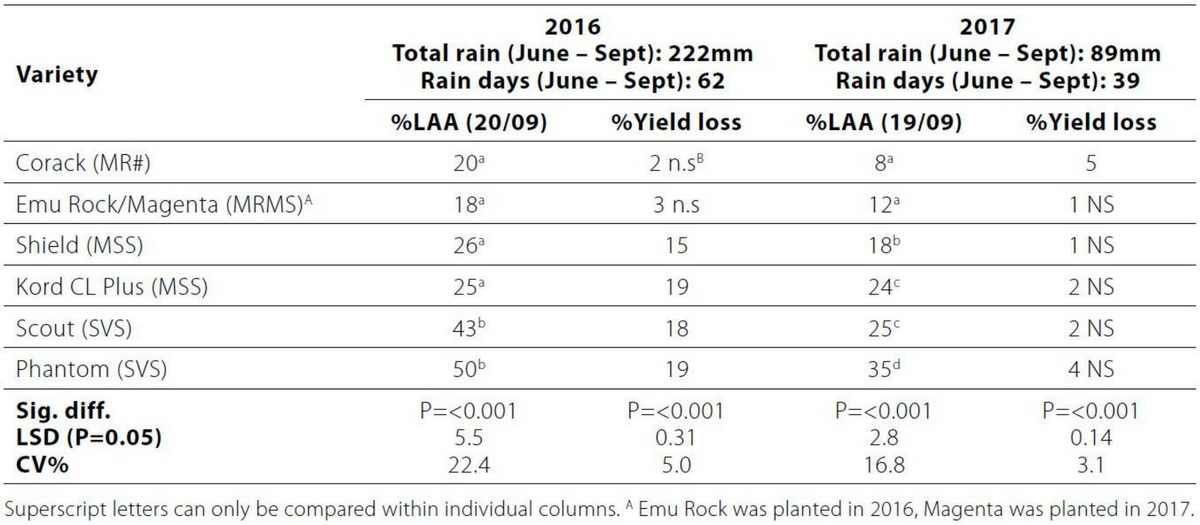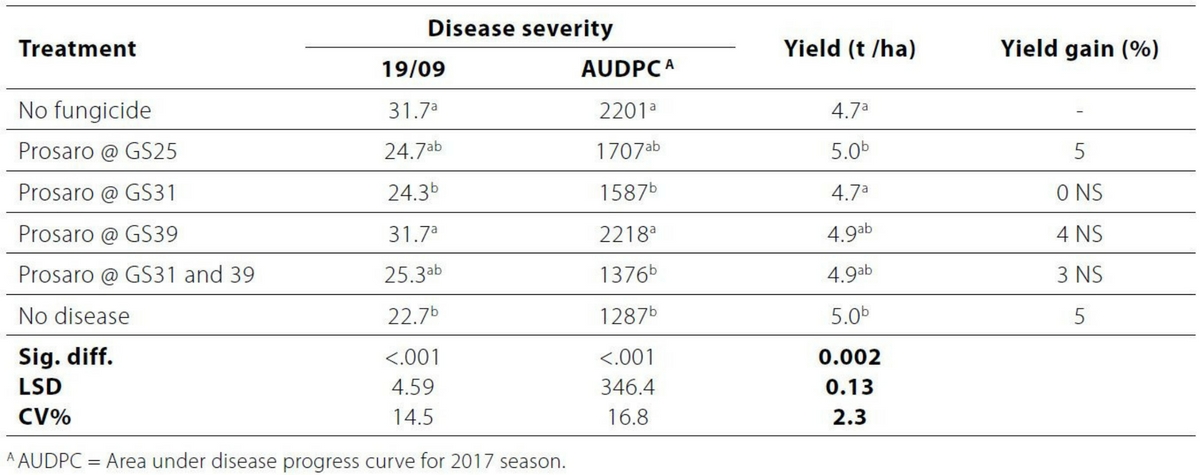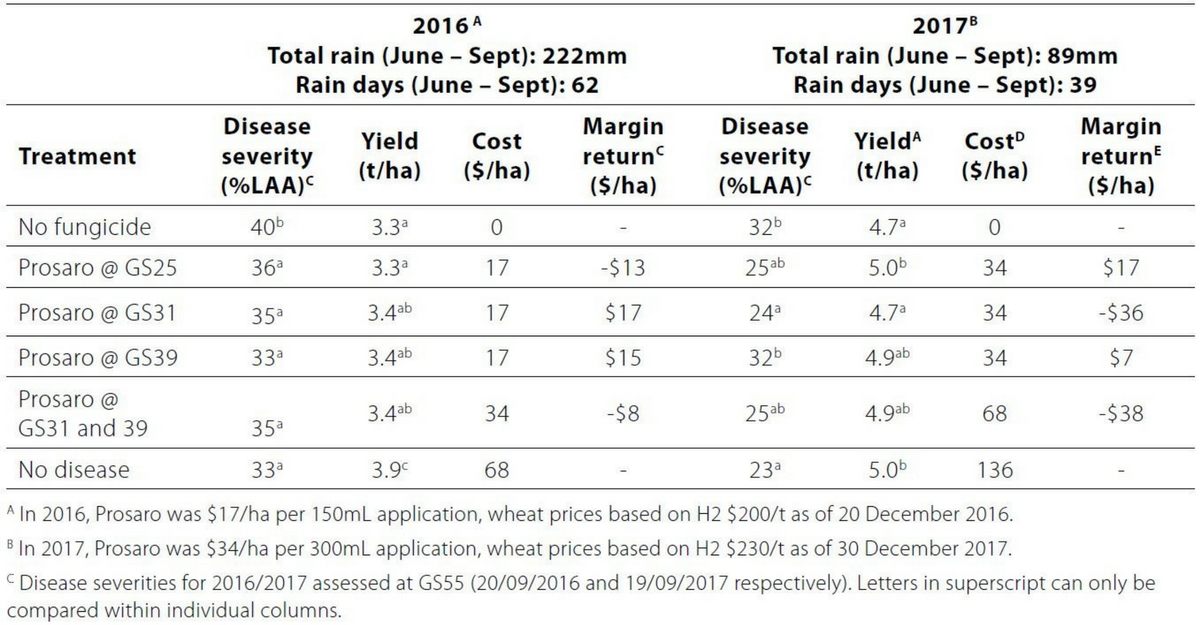Take home messages
- Yield losses due to yellow spot in wheat were minimal in 2017 (less than 5%) compared to the wetter season of 2016 (5–25%).
- Foliar fungicides provided minimal control in 2017 with yield gains from multiple sprays less than 5%.
- Avoid sowing susceptible varieties into paddocks with infected stubble.
- Foliar fungicides should not be relied on for managing yellow spot.
Background
Yellow spot is a stubble borne foliar disease of wheat that is favoured by growing susceptible wheat varieties, stubble retention practices and wet seasonal conditions. Although it is common in the Mallee region, its impact on grain yield and quality is unclear. Some consider it a disease of seedlings, which the plant outgrows, while others regard yellow spot as an important disease that warrants fungicides for its control.
Previous studies have shown that yield losses due to yellow spot can vary between seasons, with yield losses in susceptible varieties ranging from 8% (Hollaway and McColl 2015) to 25% (Cook, Hollaway and McLean 2016).
Aim
To compare yield losses associated with different resistance ratings of wheat and identify effective fungicide application strategies for management of yellow spot of wheat in the Mallee.
Paddock details
| Locations: | Curyo |
| Crop year rainfall: | 297mm |
| GSR (Apr-Oct): | 215mm |
| Soil type: | Sandy clay loam |
Trial 1: Yield loss
Trial details
| Crop type: | Wheat (See Table 1 below) |
| Treatments: | High disease (1kg infected wheat stubble applied to each plot) Low disease (1kg clean barley stubble applied to each plot and sprayed with Prosaro® @ 300mL/ha at GS31 and 39 |
| Target plant density: | 130 plants/m² |
| Seeding equipment: | Knife points, press wheels, 30cm row spacing |
| Sowing date: | 5 May 2017 |
| Replicates: | 12 |
| Harvest date: | 24 November 2017 |
Trial inputs
| Fertiliser: | Managed to maximise grain yield and quality according to soil test results |
| Herbicide: | Weeds were controlled according to best management practice |
| Insecticide: | Pests were controlled according to best management practice |
| Fungicide: | Prosaro sprayed on low disease plots at GS31 and GS39 |
Trial method
Twelve replicates of six commonly grown wheat cultivars with differing yellow spot resistance (Table 1) were exposed to either high or low disease pressure treatments in a split plot design. Double barley buffer plots were sown between each treatment block to reduce disease influence from adjacent plots.
Yellow spot severity was assessed visually (percentage leaf area affected) on five occasions: 30 June, 26 July, 8 August, 19 September and 5 October 2017. Grain yield was measured at harvest. Grain quality assessments of protein, retention, screenings and test weight were measured post-harvest.
Table 1. Cultivars and their resistances to yellow spot in the yield loss trial at Curyo in 2017.
Results and interpretation
Yellow spot severity was reduced in the presence of resistant cultivars, compared with susceptible cultivars (Table 2). The difference in disease pressure between high and low treatments was lower than expected and this reduced our ability to measure differences in grain yield due to yellow spot. This reduced difference in disease severity, combined with reduced disease pressure from yellow spot during 2017, resulted in negligible yield losses being measured (less than 5%). No effects on grain quality were measured (data not shown).
Table 2. Percentage leaf area affected by yellow spot and yield of various wheat varieties grown in low and high disease pressures at Curyo in 2017.
As shown in Table 3, yield losses measured during 2017 were much smaller than those measured during 2016. The higher number of rain days and greater rainfall during 2016, compared to 2017, is a likely explanation for the yield loss differences between the two seasons.
Resistant varieties provided the best control of yellow spot in wetter conditions.
Table 3. Disease severity and yield losses of wheat varieties with different resistance ratings under high disease pressure at Curyo in 2016 and 2017.
Trial 2: Fungicide timing
Trial details
| Crop type: | Phantom wheat (SVS) |
| Treatments: | Refer to Table 4 |
| Target plant density: | 130 plants/m² |
| Seeding equipment: | Knife points, press wheels, 30 cm row spacing |
| Sowing date: | 5 May 2017 |
| Replicates: | Six |
| Harvest date: | 14 November 2017 |
Trial inputs
| Fertiliser: | Managed to maximise grain yield and quality according to soil test results |
| Herbicide: | Weeds were controlled according to best management practice |
| Insecticide: | Pests were controlled according to best management practice |
| Fungicide: | See Table 4 |
| Disease treatment: | 1kg of yellow spot infected wheat stubble applied to each plot, except for disease free plots (1kg clean barley stubble applied) |
Trial method
Timing of foliar fungicide applications (six treatments) to control yellow spot in wheat were evaluated using a completely randomised block design with six replications at Curyo in 2017. Barley buffer plots were sown between each wheat row to reduce disease influence from adjacent plots.
Yellow spot severity was assessed visually (percentage leaf area affected) on five occasions: 30 June, 26 July, 29 August, 19 September and 5 October 2017.
Grain yield was measured at harvest. Grain quality assessments of protein, retention, screenings and test weight were measured post-harvest.
Table 4. Treatment applied to Phantom wheat infected with yellow spot at Curyo in 2017.
Results and interpretation
Regardless of the timing of application, fungicides provided minimal suppression of yellow spot in wheat (Table 5). Even though multiple fungicide applications (No Disease treatment) provided significant suppression of yellow spot relative to the untreated control, there were still relatively high levels of yellow spot present. The only significant yield increases measured, relative to the untreated control, were minimal at 5%. Treatments did not affect grain quality (data not shown). Overall, fungicides did not provide an effective control of yellow spot, or significant improvement in grain yield.
Table 5. Disease severity and percentage yield gains of Phantom wheat under different foliar fungicide treatments at Curyo in 2017.
On-farm profitability
The most economic foliar fungicide treatment over wet and moderate years was a single spray at GS39 (Table 6), however yield gains were not significantly different from untreated.
Table 6. Economic return of fungicide treatments for yellow spot control at Curyo in 2017.
Commercial practice
The best way to minimise yield loss due to yellow spot is to avoid sowing susceptible varieties sowing into paddocks where infected stubble is present.
Foliar fungicides should not be relied on to control yellow spot.
References
Hollaway G, McColl S, 2015, 2014 BCG Season Research Results, ‘Yellow Leaf Spot’, pp. 105-108.
Hollaway G, McLean M, Fanning J, Cook M, 2017, Cereal Disease Guide 201, Agriculture Victoria.
Acknowledgements
The authors acknowledge the investment and support from GRDC and Agriculture Victoria (DAV000129). We also thank the cereal pathology group at Agriculture Victoria, Horsham and the technical group at Birchip Cropping Group for their ongoing technical support.






